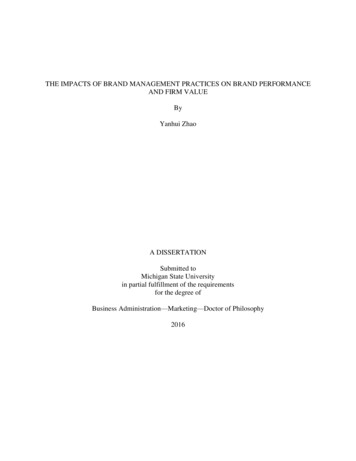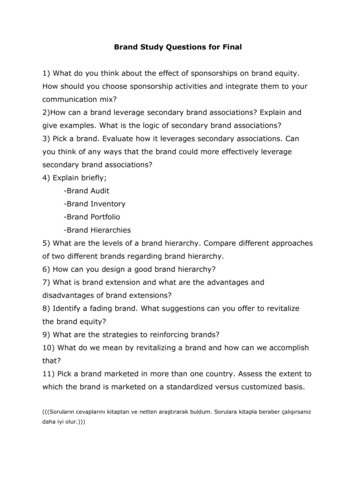
Transcription
THE IMPACTS OF BRAND MANAGEMENT PRACTICES ON BRAND PERFORMANCEAND FIRM VALUEByYanhui ZhaoA DISSERTATIONSubmitted toMichigan State Universityin partial fulfillment of the requirementsfor the degree ofBusiness Administration—Marketing—Doctor of Philosophy2016
ABSTRACTTHE IMPACTS OF BRAND MANAGEMENT PRACTICES ON BRAND PERFORMANCEAND FIRM VALUEByYanhui ZhaoBrands are among the most important of firm assets, serving as crucial sources of competitiveadvantage. The realization of such competitive advantage requires effective, robust, and flexiblebrand management practices that accommodate internal and external contingencies. Mydissertation uses two essays to investigate how a selection of brand management practicesinfluences brand performance and firm value. Essay 1 employs two studies to examine crosscategory variation in the effect of marketing mix variables on brand sales and brand equity.Empirical evidence from analyzing Information Resources, Inc. scanner data (study 1) andconsumer survey data (study 2) suggests that brand relevance in category (BRiC) – a productcategory characteristic – interacts with marketing mix decisions (e.g., product variety,distribution coverage) to affect brand sales and brand equity. The focus of Essay 2 is rebrandingstrategies that aim to update a firm’s brand image by changing brand identity or brand strategy.Empirical evidence from analyzing 229 rebranding events shows that, on average, rebrandinginitiatives are associated with positive abnormal stock returns. More importantly, these financialreturns can be predicted by the degree of rebranding and the fit between the degree of rebrandingand competitive factors (firm competitive position and industry competition intensity).
TABLE OF CONTENTSLIST OF TABLES . . vLIST OF FIGURES . . viCHAPTER 1 . .1Brand Relevance in Category and Marketing Mix Impacts 1Literature Review on Marketing Mix Influences .5Effects of Marketing Mix Variables on Objective Performance Metrics . .6Effects of Marketing Mix Variables on Subjective Performance Metrics . .8Cross-Category Variation in the Effects of Marketing Mix .9Model and Hypotheses . .10BRiC and Product Variety .11BRiC and Brand Price 12BRiC and Promotional Activities .13BRiC and Distribution Coverage .16Study 1: Marketing Mix Variables BRiC Brand Sales 17Data .17Measures .18Analysis .19Results .21Study 2: Marketing Mix Variables BRiC Brand Equity .24Data Collection . .24Questionnaire Structure and Measures . 25Measurement Validity 25Model Estimation .26Results . 27Discussion . .29Theoretical Implications 30Managerial Implications 32Limitations and Future Research .33APPENDICES .35APPENDIX A: TABLES . . .36APPENDIX B: FIGURES . . 42APPENDIX C: Study 2 Measures 44REFERENCES . .46CHAPTER 2 . 51Rebranding and Firm Value: An Event Study on Abnormal Returns to RebrandingAnnouncements .51Literature Review . . 55What is Rebranding? .55Why Rebrand? .56So What? . . 58 .iii
Conceptual Framework and Hypotheses . 59Two Dimension of Rebranding .60The Impact of Competitive Factors on Rebranding .61How Rebranding Affects Future Shareholder Value .63The Fit between the Degree of Rebranding and Competitive Factors . 66Data and Method 68Data Sources .68Measures of Key Variables 69Measures of Additional Variables .73Analysis . .76Hypotheses Testing . .77Hypothesis Testing: Model-Free Evidence 77Hypothesis Testing: Degree of Rebranding Results . 77The Worth of Rebranding .78Hypothesis Testing: Abnormal Returns Results . . .79Robustness Tests 82Discussion . 82Theoretical Implications . . .84Managerial Implications .86Limitations and Future Research .89APPENDICES . .91APPENDIX A: TABLES . . .92APPENDIX B: FIGURES . .99REFERENCES .102 .iv
LIST OF TABLESTable 1-1: Descriptive Statistics and Correlations (Study 1) . 36Table 1-2: Variance Estimates of Null Models for All Level 1 Variables (Study 1) 37Table 1-3: Three-Level Mixed Effect Model Results (Study 1, DV: Brand Sales) . .38Table 1-4: Best Linear Unbiased Predictions of Random Slopes . .39Table 1-5: Descriptive Statistics and Correlations (Study 2) .40Table 1-6: Two-Level HLM Results (Study 2, DV: Brand Equity) .41Table 2-1: Variable Operationalization . . .92Table 2-2: Correlations and Descriptive Statistics . 94Table 2-3: Degree of Rebranding Results (Path Model Part 1) . 96Table 2-4: Abnormal Returns and Test Statistics Across Various Event Windows . 97Table 2-5: Abnormal Returns Results (Path Model Part 2) . .98v
LIST OF FIGURESFigure 1-1: Conceptual Model . . 42Figure 1-2: Predicted Effects of Marketing Mix Variables in Different Categories .43Figure 2-1: Research Model . .99Figure 2-2: Degree of Rebranding and Examples 100Figure 2-3: Interactions between Degree of Rebranding and Competition Factors . . 101vi
CHAPTER 1Brand Relevance in Category and Marketing Mix ImpactsTo survive in the fiercely competitive consumer packaged goods (CPG) industry, bothmanufacturers and retailers have continuously employed marketing mix elements in extremeways. Given the strategic importance of marketing mix variables, it is not surprising that theoutcomes of marketing mix have been heavily researched. Ample evidence has shown thatmarketing mix decisions have strong effects on brand sales (Bayus and Putsis, 1999; Boulding,Lee, and Staelin, 1994) and customer-based brand equity (Yoo, Donthu, and Lee, 2000; Buil, deChernatony, and Martinez, 2013).Prior research has demonstrated not only that marketing mix variables significantlycontribute to brand sales, but also that the contribution varies across product categories (Faderand Lodish, 1990; Narasimhan, Neslin, and Sen, 1996). Research trying to identify categorylevel moderators has been fruitful. Category penetration, inter-purchase times, price levels, thenumber of brands, and consumer propensity to stockpile have been identified as key categoryvariables that moderate the effect of marketing mix variables on brand sales (Fader and Lodish,1990; Narasimhan, Neslin, and Sen, 1996). Close scrutiny of this stream of literature suggeststhat the category-level moderators identified are not exhaustive. One key category-level factoridentified by brand scholars, brand relevance in category (BRiC), has been missing from thestudy of cross-category variation in marketing mix effects.Building on the notion that consumers usually employ marketing mix variables asextrinsic brand quality cues, a stream of literature on the effects of marketing mix variables onbrand equity has found that marketing mix variables can have very different, sometimes evenopposite, effects on brand equity (Yoo, Donthu, and Lee, 2000; Buil, de Chernatony, and1
Martinez, 2013). For example, advertising expenditures and distribution channel expansion arepositive brand quality cues and thus encourage the growth of brand equity, while frequent pricepromotion is a negative brand quality cue and thus undermines brand equity. Although the abovefindings are interesting and managerially relevant, absent from this stream of literature is adiscussion of whether and how the influence of marketing mix variables on brand equity variesacross product categories.To fill the above-mentioned literature gaps, we propose and empirically test a modelhighlighting BRiC’s role in influencing the effectiveness of marketing mix decision variables.BRiC is a concept that has recently emerged from the brand management literature. It refers to“the importance of brand for consumer decision making” (Fischer, Volckner, and Sattler, 2010,).Fischer, Volckner, and Sattler (2010) noted that the overall importance of brands for consumerdecision making differs across product categories. For example, consumers care more aboutbrand name when buying razors or shampoo, while caring less about brand name when buyingpaper towels, toilet paper, or pencils. Because BRiC pertains to the importance of brand forconsumer decision making and consumers’ reaction to marketing mix variables is greatlyinfluenced by brand perception, there is a reason to speculate that marketing mix variablesinteract with BRiC (cross-level interaction) to influence brand sales (examined in study 1) andbrand equity (examined in study 2).The contribution of this research is threefold. First, we propose and validate a newmeasure of BRiC that can be computed using secondary sales data. BRiC was originallymeasured using Fischer, Volckner, and Sattler’s (2010) five-item survey scale. When using theoriginal survey scale, researchers directly ask consumers to indicate the importance of brandname when purchasing from a specific product category. This scale is a valid measure of the2
manifest motive of pursuing named brands. However, such a survey measure is less powerful incapturing latent motives (Hawkins and Mothersbaugh, 2012). For some consumers, pursuingnamed brands might be a latent motive (e.g., consumers may be reluctant to admit that brandname drives their purchases). In these cases, the original survey measure cannot captureconsumers’ motive for pursuing named brands. To overcome this problem, we propose a newproxy measure of BRiC that uses consumers’ actual choices to infer consumers’ brand-nameseeking motives.Second, we contribute to the stream of research on the effects of marketing mix variableson brand sales by modeling BRiC as a category-level moderator to explain residual crosscategory variance. BRiC is a concept introduced by Fischer, Volckner, and Sattler (2010), whichrefers to the overall importance of brand for consumers’ purchases in a specific product category.Fischer et al. (2010) revealed the general importance of the new concept. However, its relevancefor marketing mix decisions is still unclear. We attempt to estimate how the average increase inbrand sales resulting from these marketing mix elements can be explained by BRiC. To do this,we first compile a dataset covering 138,027 quarterly observations of brand-level sales, prices,product varieties, distribution coverages, feature advertisements, displays, price promotions of7,680 brands across 31 CPG categories from scanner data provided by Information Resources,Inc. (IRI). By testing a three-level mixed effect model, study 1 shows that including BRiC inestimating marketing mix variables’ effect on brand sales explains significant additional variancein brand sales. This supports our claim that BRiC is an influential category-level variable that hasbeen overlooked in prior research on the effects of marketing mix decisions.Third, to the best of our knowledge, we are the first to examine the cross-categoryvariation in the effects of marketing mix variables on customer-based brand equity. Keller (1993)3
suggested that customer-based brand equity stems from brand knowledge while the creation ofbrand knowledge is affected by customers’ exposure to a brand’s marketing activities. Priorresearch has found evidence that marketing mix variables serve as extrinsic quality cues and thusaffect customer-based brand equity (Yoo et al., 2000; Buil et al., 2013; Pappu and Quester,2008). For example, research has found that frequent price reduction may hurt a brand in thelong term because it conveys an image of unstable product quality (Winer, 1986), whereasadvertising expenditures may help establish long-term brand associations and grow brand equity(Yoo et al., 2000). While identifying factors that influence brand equity is a major priority forscholars and managers (Buil et al., 2013; Baldauf et al., 2009; Valette-Florence, Guizani, andMerunka 2011), identifying the conditions under which the influence is strong or weak should beat least equally important. However, close scrutiny of the existing research reveals significantresearch gaps regarding cross-category variation in the effect of marketing mix variables onbrand equity. Such research gaps raise crucial questions about how to design an effectivemarketing mix in different product categories if building customer-based brand equity is aprimary business goal. With these practical questions and business goals in mind, we test amultilevel model using hierarchical linear modeling (HLM) and survey data collected from 933consumers across 29 product categories. The results provide support for our claims that (1)significant cross-category variation exists in the impact of marketing mix variables on customerbased brand equity and (2) BRiC can explain this variation.We believe this research has significant managerial implications for brand managementand product category management. Given resource constraints, when making marketing mixdecisions and allocating resources to marketing activities in various product categories,marketing managers responsible for multiple product categories should assess and compare the4
returns from marketing activities across categories. Such comparison is necessary to ensure thehighest possible returns from limited marketing resources.Our multi-study research presented here is structured in the following manner. We firstintroduce the main effects of marketing mix variables on brand sales and brand equity. Giventhat prior literature has provided support for these relationships, this introduction is brief andonly serves as a basis to develop focal cross-level interaction hypotheses. We then discuss study1, which focuses on the effect of the cross-level interaction on brand sales. This is followed bydiscussion of study 2, which focuses on the effect of the cross-level interaction on brand equity.We conclude with contributions of this study and discussion of both managerial implications anddirections for future research.Literature Review on Marketing Mix InfluencesThe literature on marketing mix influences can be organized into three major streams:(1) Research on the effect of marketing mix variables on objective performance metrics(e.g., sales, profits)(2) Research on the effect of marketing mix variables on subjective performance metrics(e.g., brand equity)(3) Research on the effect of marketing mix variables on individual consumer behavior(i.e., consumer choices)We devote most of our review to articles in the first two streams because the principal issue weinvestigate deals with cross-category variation in the effect of marketing mix on brand sales(study 1) and brand equity (study 2). In this section, we review prior research on a selection ofmarketing mix variables, including product variety, price, advertising or feature advertising,5
price promotion, in-store displays, and distribution coverage. Although these variables do notembrace every element of a marketing mix, they demonstrate the effects of marketing mixvariables.Effects of Marketing Mix Variables on Objective Performance MetricsProduct variety. Product variety refers to the number of differentiated product variationsa brand offers in a product category (Ataman, Van Heerde, and Mela, 2010). A high level ofproduct variety is common in the CPG industry. Many brands rely on a high level of productvariety (or “product proliferation” strategy) to compete in the CPG industry. For example,Procter & Gamble, a product proliferation strategy pioneer, has at least 15 products under itsCrest brand, including Crest Pro-Health Intensive Clean, Crest Pro-Health Whitening Gel, andCrest Pro-Health Clinical Gum Protection.Product variety directly contributes to brand sales (Bayus and Putsis, 1999; Ataman, VanHeerde, and Mela, 2010). The underlying rationale is evident: (1) Product variety should increasea firm’s share of retail shelf space and thus increase the chance of products being selected byconsumers (Mason and Milne, 1994) and (2) a larger number of differentiated product variationsgenerates strong attraction for a wider range of consumers (especially those with high desire toseek variety) and high deterrence of new entries. Of course, too much product variety maybackfire. As the number of product variations continues to grow, it becomes increasingly hardfor the firm to continually segment the market. The likely outcome is the product cannibalizationphenomenon; that is, newly added product variations compete with the brand’s old products andthe new products’ customers are existing customers of the brand (Mason and Milne, 1994).6
Price. Economics theory provides strong support for the negative relationship betweenbrand price and brand sales. When brand price increases, consumer demand for the branddecreases correspondingly.Price promotion. The literature has long recognized that price promotion is thepredominate form of competition in the CPG industry (e.g., Walters and MacKenzie, 1988).Ample evidence suggests that price reductions affect consumer purchase decisions. Increasedsales in response to price reductions can stem from two major sources: (1) Current brandcustomers may stockpile due to the price reductions and (2) competitors’ customers may switchto the brand temporarily (Hawkins and Mothersbaugh, 2012).Feature advertising. Feature advertising refers here to the weekly advertising of productsin newspaper inserts and store fliers. Feature advertising is more cost-efficient than TVadvertising in communicating product information to customers (Srinivasan and Bodapati, 2006).The effects of feature advertisements on brand sales are well studied in prior research (Zhang,Wedel, and Pieters, 2009; Blattberg, Briesch, and Fox, 1995; Dhar, Hoch, and Kumar, 2001). Forbrands, feature advertising is informative advertising. A brand uses feature advertising to informconsumers of the brand’s availability, price, and discounts. Thus, feature advertising affectsconsumer purchase decisions through its effect on consumer attention (Zhang, Wedel, andPieters, 2009; Stegeman, 1991). For retailers, feature advertising attracts customers fromcompetitors and builds store traffic and volume (Srinivasan and Bodapati, 2006).In-store displays. In-store displays are also used to inform consumers of productavailability, prices, and discounts. It is well documented in the literature that in-store displayspositively affect brand sales (e.g., Chevalier, 1975).7
Distribution coverage. One of the key aspects of channel management in the CPGindustry is deciding how many stores or retail outlets through which to sell the products in agiven geographic area (Stern, El-Ansary, and Coughlan, 1996). If a brand is distributed in a largenumber of stores, we say that the brand has high distribution coverage. Obviously, distributioncoverage affects brand sales. After a brand expands to a new geographic area and is available ina larger number of stores, brand sales can increase dramatically (Aaker, 1996; Frazier, 1999;Frazier and Lassar, 1996).Effects of Marketing Mix Variables on Subjective Performance MetricsProduct variety. Prior research suggests that product variety is an important extrinsic cuethat consumers use to infer brand quality (e.g., Berger, Draganska, and Simonson 2007). A highdegree of product variety within a brand can be an indicator of the brand’s strength andpopularity, which reduces consumers’ perceived risk in purchasing.Price. Consumers use price as an indicator or reference of product quality. The literaturedocuments that consumers perceive a high-priced brand as having higher quality and highervalue (Rao and Monroe, 1989). Thus, price has a positive association with brand equity (Yoo,Donthu, and Lee, 2000).Price promotion. Prior research suggests a negative impact of price promotion oncustomer-based brand equity. Frequent price promotions convey a low-quality brand image(Winer, 1986) and, thus, eventually erode brand equity (Yoo, Donthu, and Lee, 2000).Advertising. Advertisements have been identified as major tools for a firm to buildcustomer-based brand equity (Keller and Lehmann, 2003; Sriram and Kalwani, 2007). Thecontent and frequency of advertising affect different elements of brand equity. By using variouscontent appeals, a brand can communicate its functional and emotional value to consumers and8
build strong, favorable brand associations in consumers’ minds (Buil, de Chernatony, andMartinez, 2013; Yoo, Donthu, and Lee, 2000). The frequency of advertising also affects brandawareness and brand recall. Intense advertising programs capture consumers’ attention,improving consumers’ ability to recognize and recall the brand (Yoo et al., 2000; Buil et al.,2013). Consumers also use the intensity of advertising programs as a quality cue (Milgrom andRoberts, 1986; Kirmani and Rao, 2000). Consumers usually perceive brands with highadvertising intensity as reliable (e.g., Moorthy and Hawkins, 2005).In-store display. Prior research has not studied the influence of a brand’s in-store displayon brand equity.Distribution coverage. High distribution coverage is associated with higher customersatisfaction as it reduces consumers’ effort and time spent in purchasing and makes it convenientfor consumers to buy (Yoo, Donthu, and Lee, 2000; Ataman, Van Heerde, and Mela, 2010).Research has found that consumers perceive high utility and value for intensively distributedbrands (Yoo, Donthu, and Lee, 2000). Also, distribution coverage is associated with perceivedproduct quality as high coverage indicates higher brand power and reputation (Fein andAnderson, 1997).Cross-Category Variation in the Effects of Marketing MixA general agreement seems to exist among managers and scholars that consumers displaydifferent reactions to marketing mix activities when purchasing in different categories. Certainmarketing mix variables are more effective in driving brand sales in some categories than others.For example, an industry report by IRI suggests that a 15% price reduction accompanied byfeature advertisements increased sales of the promoted toilet tissue product by 440.5%. The samepromotion for a pasta brand increased sales by 198.1% and that for a deodorant brand yielded an9
increase of 102.0%. Thus, category-level analysis is important for both manufacturers andretailers to make more informed marketing mix decisions regarding resource allocation amongmarketing activities.Prior research on cross-category variation in marketing mix effectiveness has beenfruitful. Curhan (1974) found that slow-selling fruits were more affected by changes in displayspace than fast-selling items. Using an experiment, Chevalier (1975) provided further support byshowing strong differences in display effectiveness across product categories. Fader and Lodish(1990) studied 331 product categories and reported that categories with higher categorypenetration, shorter inter-purchase times, higher private label share, and lower price levels hadhigher volume sold due to price deals. Narasimhan, Neslin, and Sen (1996) studied 108 productcategories and used data compiled from weekly scanner data. These authors reported that CPGcategories with fewer numbers of brands, higher category penetration, shorter inter-purchasetimes, and higher consumer propensity to stockpile had higher promotional elasticities.Srinivasan et al.’s (2004) research revealed that manufacturer revenue elasticities are higher incategories with lower private-label share, for impulse-buying products, and in categories withfew stock keeping units (SKUs).Model and HypothesesGiven the research findings presented in the literature review, it is not surprising thatmanufacturer and retailer management has given – and continues to give – considerable attentionregarding resource allocation to marketing mix activities across categories. To provideunderstanding around such decisions, we propose a conceptual model (Figure 1) that highlights10
the moderating effect of BRiC on the effect of marketing mix variables on brand sales (H1aH6a) and brand equity (H1b-H6b).BRiC and Product VarietyThe contribution of product variety to brand sales is contingent on the likelihood andseverity of product cannibalization. We expect that the problem of product cannibalization maybe more severe in high-BRiC categories than in low-BRiC categories. Cannibalization occurswhen newly added product variations compete with a brand’s existing products. In high-BRiCcategories, brand name plays an important role in consumer decision making (Fischer, Völckner,and Sattler, 2010). Hence, when purchasing from high-BRiC categories, consumers are loyal tocertain brands in repeat purchases. Thus, it is difficult for new product variations to attract newconsumers from competing brands. As a result, the primary consumers who purchase newlyadded product variations are old customers loyal to the brand. Conversely, when buying fromlow-BRiC categories, consumers make decisions not based on brand name but on other factorssuch as function, price, and design. Because consumers are less loyal to certain brands, theproblem of cannibalization is less severe. As a result, the magnitude of the sales increaseassociated with adding product variations is less constrained by cannibalization in lower BRiCcategories. More formally,H1a: The positive effect of product variety on brand sales is weaker in product categoriescharacterized by high BRiC than those characterized by low BRiC.Even though BRiC negatively moderates the effect of product variety on brand sales, itmay nonetheless positively moderate its effect on customer-based brand equity. Research hassuggested that consumers use product variety as an important quality cue (Berger, Draganska,and Simonson 2007). It is not surprising that consumers perceive a brand offering a high degree11
of product variety or occupying a large proportion of shelf space as a powerful and popularbrand. This perception greatly reduces consumer perception of purchase risk. In a high-BRiCcategory, the role played by product variety as a quality cue is even more salient. This is becausein high-BRiC categories where consumer decisions are driven by brand name, consumers rely onsuch indicator to infer a brand’s quality. Such inference is less important in low-BRiC categoriesbecause consumer decisions are not evidently affected by brand name, and consumers do notneed such indicator to infer brand quality. More formally,H1b: The positive effect of product variety on brand equity is stronger in productcategories characterized by high BRiC than those characterized by low BRiC.BRiC and Brand PricePrice elasticity of demand is usually negative, meaning that a negative relationship existsbetween brand price and brand unit sales. However, such negative relationship may be strong orweak in different product categories. We propose that the negative relationship is weaker (lessnegative) in high-BRiC categories than in low-BRiC categories because consumers are lesssensitive to price changes when brand name plays a salient role in their purchase decision(Erdem, Swait, and Louviere 2002). When purchasing in a high-BRiC category where brandname is important, consumers are willing to pay a higher price premium for the brand name thanwhen purchasing in a low-BRiC category where brand name is less important (Fischer,Völckner, and Sattler, 2010). Accordingly, consumer choices are less sensitive to price changesin categories characterized by higher BRiC. For example, beer is a typical high-BRiC categorywhere consumers regard brand name as important. A 5% increase or decrease in a beer brand’sprice may not change either its own or its competitors’ consumers’ choices significantly becauseconsumers tend to stay loyal to certain brands. When we look at the milk category where12
consumers usually do not consider brand name as important, the same 5% increase or decrease ina milk brand price can significantly change consumer choices. Based on the above reasoning, wepropose thatH2a: The negative effect of brand price on brand sales is weaker in product categoriescharacterized by high BRiC than those characterized by low BRiC.Given that consumers use both brand price and product variety as extrinsic quality cues,BRiC should interact with brand price to affect brand equity in a similar pattern as with productvariety (H1b). Similar to product variety, brand price is an important signal of brand quality (Raoand Monroe, 1989). Consumers have a higher tendency to associate such cue with brand qualitywhen purchasing in a high-BRiC category than in a low-BRiC category. For example, if a bottledbeer is priced at 15, consumers would infer that the beer is a premium beer and the brand is ahigh-end bra
brand management practices that accommodate internal and external contingencies. My dissertation uses two essays to investigate how a selection of brand management practices influences brand performance and










